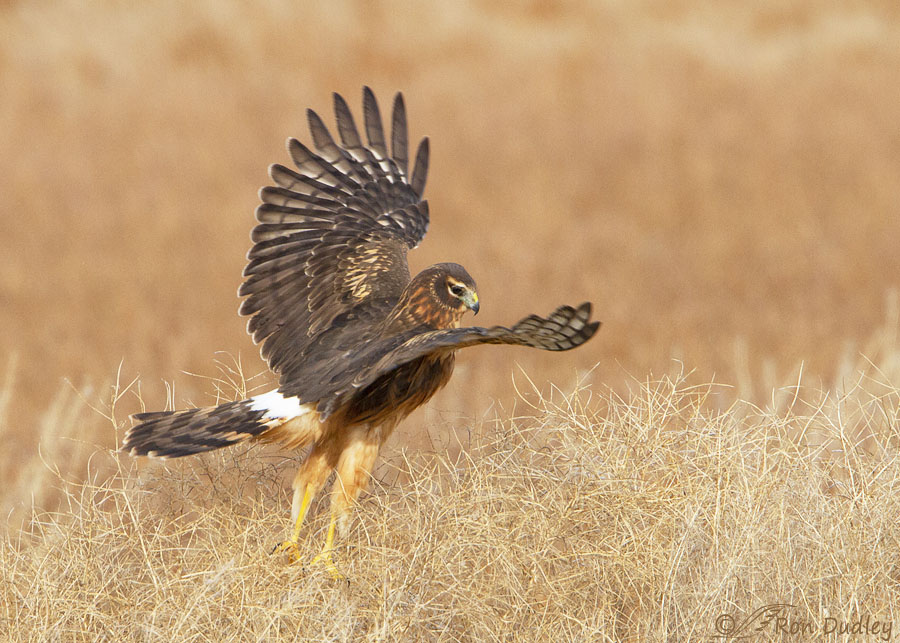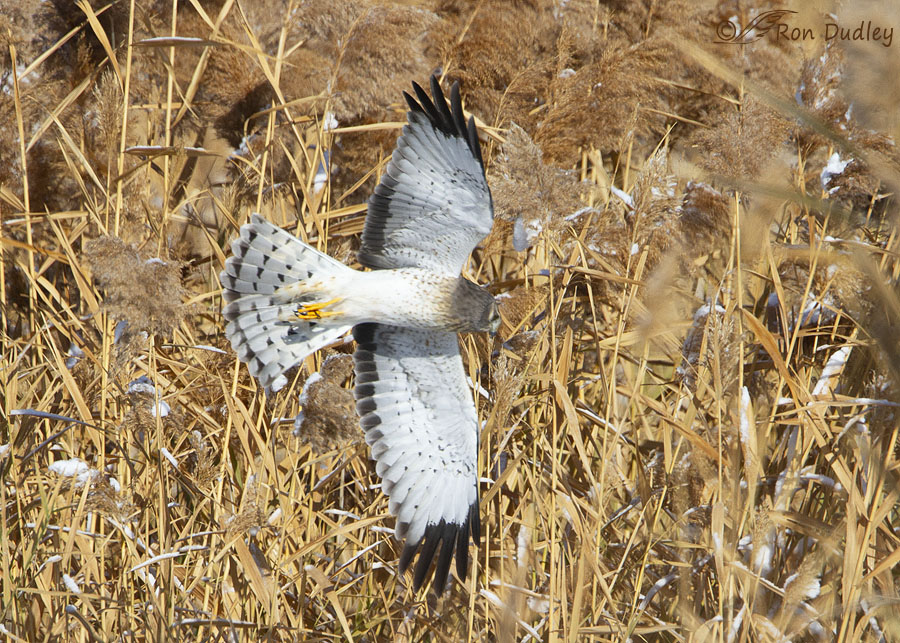But I like them anyway.
Some blog followers may think I’m more than a little anal about rejecting photos out of hand that lack light in the eye, i.e. a catch light. And maybe I am. But in reality I don’t always reject them. When the bird’s eyes are brightly colored or for photos whose primary purpose is documenting behavior or some interesting physical feature of the bird I don’t think light in the eye is absolutely critical.
So there are times when none of the above are true and I still like the photo well enough to post it to Feathered Photography. The following Northern Harrier photos are proof positive.

1/2000, f/7.1, ISO 640, Canon 7D, Canon EF 500mm f/4L IS II USM + EF 1.4 III Extender, not baited, set up or called in
I caught this young female as she was taking off at Farmington Bay WMA. There’s no light in her dark eye but in my view that deficiency is sufficiently mitigated by her graceful, athletic posture and her head turn that provides the viewer with a good look at her face. She stands out extremely well against the natural setting and background and the lighting angle is just about perfect. I really like her rich colors in this warm light.

1/2000, f/7.1, ISO 640, Canon 7D, Canon EF 500mm f/4L IS II USM + EF 1.4 III Extender, not baited, set up or called in
This male was also photographed at Farmington. Adult male harriers like this bird have bright lemon-yellow eyes but not only is there no catch light visible, we don’t even have a clear look at his eye.
What strikes me most about the photo is the steep banking flight posture I caught him in as he was hunting. Few other large raptors would even attempt this maneuver so close to the ground and with the phrags almost within scraping distance behind the bird because of the very real danger of crashing and burning. But harriers as a species are unusually athletic in flight, the males even more so because they’re smaller and more maneuverable in flight than females, so this risky stunt is a fairly typical occurrence with them. I was just lucky to capture it.
This bird’s undertail coverts also catch my eye. They’re arranged in two matching ‘clumps’ pointing backward between his feet and upper tail that remind this biologist of shark claspers. If I’ve noticed this feature in harriers before for some reason I’ve never paid much attention to it.
Do I wish I had a catch light in the eye of both harriers? You bet I do. But no photo is perfect and depending on one’s tastes and preferences and the context of the image some ‘flaws’ can be mostly overlooked. Sometimes.
Ron


Ed Mackerrow suggested I follow your blog Ron. He commented that not only were you a fine bird photographer but one of the most ethical wildlife photographers. Now having seen some of your photos, Ed is correct.
Welcome, Wayne, and thank you. I have a lot of respect for Ed too, for the same reasons you mention and others.
Mrs. NOAH takes my breath away, catchlight not necessary to admire the elegant style of this beauty. And Mr. NOAH’s head did take me awhile to locate, as did his undertail coverts (obvious to me once I viewed the shark’s claspers). I’m much impressed with his fighter jet maneuver and that you caught it!
Ron, the female looks like a can-can dancer, swirling her skirts!
Many times, looking at your amazing photos, I see a dramatic dance recital – the movements, the costumes, the lighting. Wow!
And the male, he’s giving lessons to the “Top Gun” stunt pilots – “Here, guys, this is how it’s done!”
Thanks for the best entertainment of the day.
Carolyn
Thanks, Carolyn. You’re right on both counts.
Oooh. And ahhh.
I am glad that your very stringent standards could be relaxed for these stunners.
Thanks, EC. See, my middle name is Flexible…
Of course, these are beautiful photos, and likely the only way I’ll ever see them up close. A couple of questions:
Those are patches of snow around the Gray Ghost, right?
Now that we know that sharks have claspers and what their function is, what is the function of those under tail coverts? Could they be “ retained basic rump feathers” as mentioned in BotW?
Thanks, Lyle.
1. Yes, that white stuff is snow on the phrags.
2. I’m afraid I’d only be guessing.
Still despite what you feel are flaws, they are both great photos.
I’m glad you like them, April. I do too, actually.
You should have your lens back today?
Yup, at least that’s the plan. That’s why I’m stuck at home on a sunny day. Could be as late as 8 PM for delivery so it could be a very long day. Hell, I can’t even go out back and work in the garden for fear I’ll miss the delivery.
What I love in the first photo is the arc in the right wing in which I can see how
enormous “Lift” would be assisted……I’m with Arwen about the second– I’ve
looked at the image repeatedly, and still can’t make out the head at all . The
clear look at the underside is beautiful though( including the “claspers”–new concept to me !)
I guess they help make the male triply effective in courtship ?
“I guess they help make the male triply effective in courtship ?”
Kris, I’d say doubly effective in mating. Sharks don’t have true penises but their two claspers are functional substitutes.
I think this is a beautiful bird and a beautiful photo. It helps me identify the Harrier. All your photos are educational. Thank you.
Take Care,
Kaye
Good. Thanks, Kaye.
Beautiful! Love the pose and the rich brown color of the female and light contrast of the male plus the sharp bank close to the ground….. As always, educational – “shark claspers” are new to me.
As always, educational – “shark claspers” are new to me. 
Judy, some folks think sharp claspers are penises. They aren’t, though penises and claspers do have one similar function.
Both very interesting photos. The idea of dumping the first one because there is not sufficient catch-eye would be appalling to this hobbyist photographer. Her against that natural background in that pose with the wings uplifted is perfect, and there is just enough light there to clearly show the eye. A keeper.
In the second one his underside colors against the phrags really stands out beautifully against the phrags and also shows off their remarkable flying skills. Also a keeper.
Thank you, Everett.
The second picture? I didn’t see the head at first. So there’s that. It really disappears for me.
You’re right, it doesn’t stand out particularly well but it’s there.
Very interesting Ron. I never heard of shark claspers.
Thank you very much.
And count me between those who think that you are a bit harsh about the quality of your photos.
Thanks, Jorge. In my view it’s better to be too harsh than too lenient. Finding the perfect middle ground that works for everyone is far from easy.